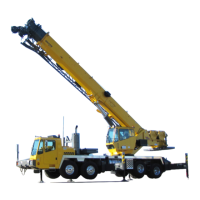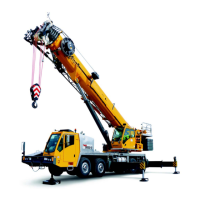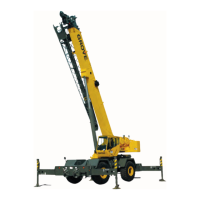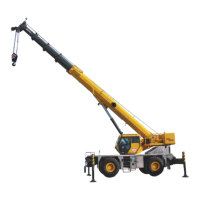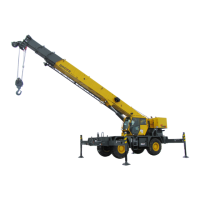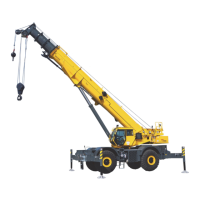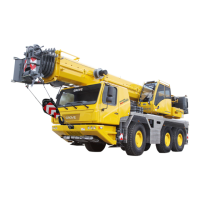8-21
TMS800E SERVICE MANUAL UNDERCARRIAGE
Published 01-29-2014, Control # 496-00
BRAKES
Description
The front and rear brakes are air actuated brakes which are
cam operated and employ shoe and lining assemblies. The
shoes are fabricated of steel, mounted on individual anchor
pins, and supported by open type spiders. Automatic slack
adjusters maintain the proper adjustment for the pushrod
stroke and lining-to-drum clearance. The cam is actuated by
the air chamber.
NOTE: For more information on the brakes, refer to
Volume 2 - Service Maintenance Manual or the
Arvinmeritor web site.
Rear Brake Spring Brake Actuator
The spring brake actuator, which is the upper part of the air
brake chamber, is spring applied and air released. When an
air pressure of 4.82 bar (70 psi) or more is applied against
the piston, the spring is compressed and braking is done with
the service brakes. When the air pressure is removed, the
spring pushes against the piston and diaphragm plate to
apply the brake. Internal venting works in conjunction with a
one-way breather cap that allows system air to fill the
vacuum behind the piston to keep out atmospheric air and
contamination. The unit is equipped with a manual caging
bolt to permit safe handling and service work.
Maintenance
Non-Asbestos Warning
Most brake linings no longer contain asbestos fibers. These
fibers may be glass, mineral wool, aramid, ceramic, or
carbon. Current regulations do not cover non-asbestos
fibers. Medical experts do not agree about the possible long
term risks of working with and breathing non-asbestos fibers.
But some experts think that long term exposure to some non-
asbestos fibers could cause pneumoconiosis, fibrosis, and
cancer. Therefore, it is recommended that workers use
caution to avoid dust when working on brakes.
1. Whenever possible, work on brakes in a separate area
away from other operations.
2. Always wear a respirator approved by NIOSH or MSHA
during all brake service procedures. Wear the respirator
from removal of the wheels through assembly.
3. NEVER use compressed air or dry brushing to clean
brake parts or assemblies. OSHA recommends that you
use cylinders that enclose the brake. These cylinders
have vacuums with high efficiency (HEPA) filters and
workmans’ arm sleeves. If such equipment is not
available, carefully clean parts and assemblies in the
open air.
4. Clean brake parts and assemblies in the open air. During
disassembly, carefully place all parts on the floor to
avoid getting dust into the air. Use an industrial vacuum
cleaner with a HEPA filter system to clean dust from the
brake drums backing plates and other brake parts. After
using the vacuum, remove any remaining dust with a rag
soaked in water and wrung until nearly dry.
5. Grinding or machining brake linings. If it is necessary to
grind or machine brake linings, additional precautions
should be taken because contact with fiber dust is higher
during these operations. In addition to wearing an
approved respirator, such work should be done in an
area with exhaust ventilation.
6. Cleaning the work area. NEVER use compressed air or
dry sweeping to clean the work area. Use an industrial
vacuum with a HEPA filter and rags soaked in water and
wrung until nearly dry. Used rags should be disposed of
with care to avoid getting dust into the air. Use an
approved respirator when emptying vacuum cleaners
and handling used rags.
7. Worker clean-up. Workers should wash their hands
before eating or drinking. Working clothes should not be
worn home. They should be vacuumed after use and
then should be laundered separately, without shaking, to
prevent fiber dust from getting into the air.
Reference Only

